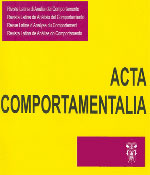Efectos de distintas probabilidades de eventos en los criterios de ajuste en tareas de aprendizaje probabilístico
Contenido principal del artículo
Resumen
Se realizaron dos estudios de aprendizaje probabilístico, con niños de 5o. Grado de primaria y con estudiantes universitarios, para evaluar el ajuste predictivo inducido por diferentes tipos de instrucciones. Se emplearon cuatro distribuciones de probabilidad diferentes: 0.5-0.5 aleatoria, 0.8-0.2 aleatoria, 0.5-0.5 no aleatoria y 0.8-0.2 no aleatoria. Las instrucciones proponían cuatro distintos criterios de ajuste a la tarea: por dogma, por referencia, por entrenamiento y por fe. Se encontraron efectos facilitadores de las instrucciones de dogma y entrenamiento sobre la ejecución en los sujetos adultos, que tuvieron el desempeño más bajo en la condición de fe. Los grupos de niños probados en la condición de fe y de dogma mostraron la peor ejecución. No se observaron efectos sistemáticos de la probabilidad empleada y su criterio de distribución, aleatorio o no aleatorio, en los porcentajes de respuestas correctas y los patrones de cambios de elección. En algunas ocasiones, las distribuciones de elecciones tendieron a ajustarse a las distribuciones de probabilidad.
Detalles del artículo
Citas en Dimensions Service

<a rel="license" href="http://creativecommons.org/licenses/by-nc-sa/4.0/"><img alt="Licencia de Creative Commons" style="border-width:0" src="https://i.creativecommons.org/l/by-nc-sa/4.0/88x31.png" /></a><br />Este obra está bajo una <a rel="license" href="http://creativecommons.org/licenses/by-nc-sa/4.0/">licencia de Creative Commons Reconocimiento-NoComercial-CompartirIgual 4.0 Internacional</a>.
